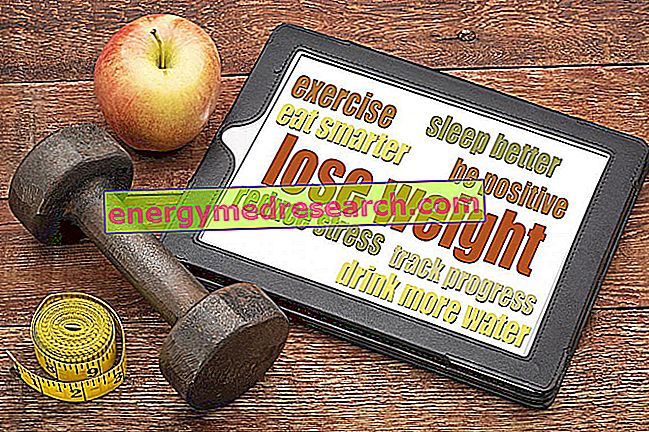By Dr. Antonio Parolisi
In a state of body balance, the loads used, during the practice of an exercise, are distributed equally on both lower limbs, across the pelvis and along the entire column; joint stresses are uniform and musculoskeletal stresses are symmetrical.
But what would happen if for any reason there was an alteration of the body balance during the stress induced by the physical exercise loads?
The loads would not be distributed equally on both lower limbs; the pelvis would have unbalanced stresses on both hemibacines and the column would also be affected in some points that compensate for this imbalance.
Result...? Problems...!
Joint pains, muscular tensions, early arthrosis, ligamentous overload, functional limitations of movements, therefore stopping or stopping progress in improving physical fitness and well-being, if it is about Mrs. Maria, or even worse suspension of the best athletic performance, if these are top level athletes.
Certainly it is true that the practice of physical exercise involves risks that must be put on a budget, but it is also true that it is necessary to choose those lines of technical-sporting thought that allow us to optimize the results while minimizing the risks.
If we consider the exercise of the Squat, in a condition of altered postural state, it can lead to a series of problems that with the silent capacity of repeated microtraumas create problems that are often disproportionate, when they can be traced back to the cause that determined them.
A subject in normopostura, therefore that is in a condition of well balanced loads on both feet, will have a fairly fair subdivision of the solicitations given by the resistance imposed by the exercise. In other words, if the subject weighs 100kg he will have a homogeneous distribution on both limbs. In practical terms it will load 50% of the weight on the right and 50% of the weight on the left; in our case 50kg on the right and 50 kg on the left. Using an extra 100 kg load on a barbell in the Squat exercise, we will have 100kg on the left and 100kg on the right. We could say that everything is ok! If the subject enjoys good flexibility and all those "ingredients" necessary for the practice of performing as correctly as possible, he will achieve excellent results in safety and comfort.
But if for a given reason the same person had a problem that alters his postural condition in minimal terms to such an extent that even he is unaware of it, and continues to train with the 100 kg Squat, the problems would be coming. It would only be a matter of time.
Suppose that for a cause not apparently attributable to an event, this person had a rotation of an emibacine. This condition would lead to a functional shortening or lengthening (not structural-anatomical) of a lower limb, those that in the jargon of manual medicines we define "false short leg or false long leg". Given that this type of problem is not only due to the rotation of the pelvis but also to the hip, knee and ankle or even from above, here we will limit ourselves only to describing the concept and not the list of postural biomechanical alterations; therefore the problem of the pelvis will inevitably lead to a disparity of the lower limbs which will lead to an overload on the side of the "short leg" which, for compensation, will be forced to shoulder the greatest load. Greater stress on the ankle in question compared to the lateral counter; same speech for the knee and hip as for the lateral cons. The sacroiliac joint under stress, more and more compared to the lateral counter and alteration of the sagittal curve of the column with greater overload in some points than in others and so on up to the cervical tract. All this, of course, in the standing position without exercise, without additional loads but only while standing. Imagine with Squat loads ...
The functional shortenings are often minimal and of the order of a few millimeters! Too often they go unnoticed, when they are the first defendants of disorders of a disproportionate level compared to their origin. The Personal Trainer is not a therapist, nor a Medical-Orthopedic Surgeon, but he can certainly make use of some methods to evaluate a subject and consider the problems to be kept in mind when writing a gymnastics program.
In the first analysis the height of the iliac crests should be evaluated (FIGURE 1)

(FIG1) Evaluation of Iliac Crests
From this first approach different useful information can be obtained and to understand if a subject finds himself / herself / itself with a not leveled basin for various causes (...) and in any case, however, it is had the possibility to underline a postural alteration very often enough evident and not to be overlooked. The iliac crest that turns out to be lower leads us to think that the corresponding leg will probably be shorter than the other. The reason for this imbalance may not be obvious and known and among other things it is not our responsibility; what we want is to highlight an asymmetry. Everything here, to then continue in our investigation.
The subject is placed in a supine position and the length of the lower limbs is evaluated at the level of the tibial malleoli (internal) (FIGURE 2)

(FIG2) Evaluation of Media Malleoli
Obviously the malleolus that turns out to be higher than the other will correspond to the side of the "short leg".
Before appreciating the length of the limbs it is good that the pelvis is lifted from the couch to the subject, in ways that cancel all the tensions of asymmetries that can be created by assuming its supine position, and then reposition the extended legs on the couch without it the subject helps us. From here we can appreciate the length of the legs and we can see the possible asymmetry.
It should be noted that most likely, the difference will not be as striking as expected and this may be due either to a very minimal problem or because in a non-loaded position, therefore lying down, the subject compensates well and hides his problem. In this case and for confirmation we continue in the investigation.
A double-scale evaluation (FIGURE 3) will confirm what we thought.

FIG 3 Weight evaluation on 2 scales
The subject climbs on the scales and evaluates the difference in weight between one side and the other. With this very ancient criterion, we can have very useful information and orient ourselves towards a line of thought as much as possible.
If the difference is noticeable, the ideal would be to postpone the subject to a professional of body rebalancing, such as the Osteopath or the Chiropractor, who with appropriate manipulations will restore the correct postural order. Their advice would always be better and always before embarking on a gymnastics program.
In any case, it should be borne in mind that the use of a rise in the functionally shorter leg is not the solution because it involves fixing an existing problem. It would only be masquerade. If, on the other hand, the leg was actually shorter due to congenital or fractured or other causes, the Orthopedic Physician will know how to behave and evaluate a suitable orthosis for that lower limb.
The objective of these lines is to make the Trainer understand the importance of evaluating his client and taking into consideration that a postural decompensation can alter the entire body mechanics. All of this amplified by additional loads of exercises like the Squat. In fact, if we take the example above, the subject who weighed 100 kg, if he had a greater overload on one side, especially visible on the scales, would have a single-sided overload even more accentuated by the loads of the exercise. Let's say that on the right side the scale shows 55 kg and on the left side 45, with the addition of 100 kg with a barbell on the shoulders, the overload on the left leg would be 90 kg while on the right leg it would be 110 kg !!! We are talking about 20 kg more on ankle, hip knee and right sacroiliac. Uneven imbalances and asymmetric stresses along the entire column. This is because the subject has 45% of the body weight on the left and 55% on the right side. Every time you want to work symmetrically you will always have more overload on the right than on the left, all proportionate to the size of all the loads used in the exercises while standing. From lying or sitting things are not so dramatic because the lower limb component is deactivated or rather, the "ascending" component, as it is defined in Posturology.
The question to be taken into consideration immediately could be to choose monolateral exercises such as the posterior lunges where alternately the legs are worked in such a way as to concentrate the work equally on the right and on the left. - this at least until the time when a good postural structure and a homogeneous redistribution of the loads have not been re-established with the collaboration of other professional figures -.
The Personal Trainer has at his disposal some tools that allow him to highlight a problem and behave accordingly; it will not solve the problem but for sure it will be able to behave in such a way as not to cause further damage and moreover it will be able to make itself very useful to the customer in sending him back to specialists who can put him back in equilibrium condition. This leads us once again to think that we are not all equal and that the observation of a subject is of fundamental importance if we have at heart the health and well-being of those before us.
Bibliography



